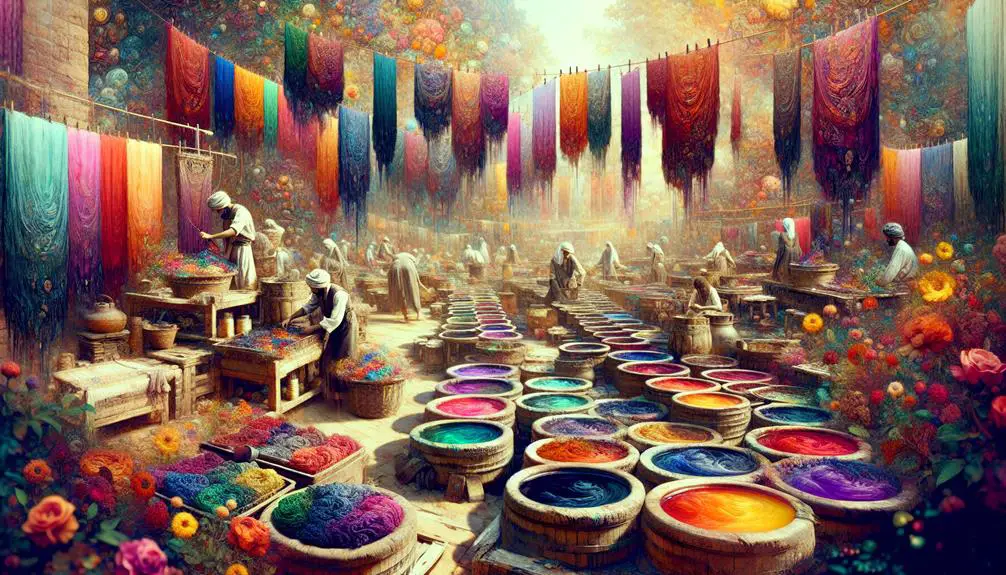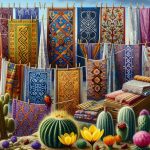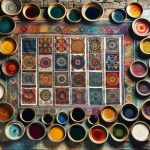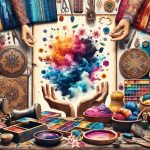Imagine a single thread, dyed with vibrant indigo in ancient India, symbolizing the intricate tapestry of fabric dyeing history. You'll find that this art form has spanned millennia, from the natural dyes of ancient Egypt to the synthetic breakthroughs of the Industrial Revolution. Each technique, whether using plants or chemicals, tells a story of human ingenuity and cultural expression. What makes these methods not just a craft, but a cultural cornerstone? Understanding this might transform how you view the clothes you wear every day.
Table of Contents
Key Takeaways
- Ancient civilizations used natural elements like plants and minerals for stunning textile dyeing results.
- Plant-based dyes like indigo, madder, and turmeric offered vibrant, eco-friendly hues in traditional dyeing practices.
- Mordants were crucial in ancient dyeing processes for color adherence and longevity.
- The Industrial Revolution introduced synthetic dyes, enhancing color variety but impacting the environment.
- Dye symbolism in different cultures reflects traditional rituals, practices, and artistic expression.
Early Beginnings
In the early days of human civilization, people discovered that natural elements like plants and minerals could be used to dye fabrics. You'd be amazed at how these early methods laid the foundation for fabric dyeing as commonly understood.
By harnessing the colors found in their environment, ancient cultures created vibrant textiles that weren't only functional but also held cultural significance.
When you explore the ancient origins of fabric dyeing, you'll find that different civilizations had their unique approaches. For instance, the Egyptians used plant-based dyes like indigo and madder to achieve rich hues. Meanwhile, in China, artisans extracted colors from tree bark and roots to create intricate designs. Each region had its preferred materials and techniques, reflecting their local flora and resources.
It's intriguing to see how early methods were both innovative and sustainable. These ancient artisans didn't rely on synthetic chemicals; instead, they utilized what's available in nature. You can admire how this ingenuity allowed them to produce long-lasting colors that have stood the test of time.
Ancient Techniques
As we explore ancient techniques, you'll discover the ingenious methods early artisans used to achieve stunning fabric dyeing results. These traditional methods, deeply rooted in cultural practices, showcase a blend of global influences and local innovations.
From the intricate tie-dye patterns of ancient India to the resist-dyeing techniques in Japan, you'll see how these methods weren't just about aesthetics but also about preserving cultural identity and heritage.
The historical significance of these techniques can't be overstated. In Egypt, for instance, fabric dyeing was so advanced that colorful linens were used in mummification processes, symbolizing the wearer's social status and beliefs about the afterlife.
Similarly, in ancient Peru, the Paracas civilization used complex weaving and dyeing techniques to create textiles that are still admired today for their vibrant colors and detailed patterns.
Artistic evolution played a pivotal role in the development of these dyeing techniques. As societies interacted through trade and conquest, they exchanged not only goods but also knowledge. This cross-pollination led to an enriched tapestry of textile artistry.
Natural Dyes
When you explore natural dyes, you'll find ancient dyeing techniques heavily relied on plant-based color sources.
Think about how early artisans used ingredients like indigo leaves and madder roots to create vibrant hues.
These methods connected them to the natural world, using what was readily available to produce stunning textiles.
Ancient Dyeing Techniques
For centuries, ancient civilizations mastered the art of dyeing fabrics using natural sources like plants, minerals, and insects. You can trace this mastery back to traditional methods that weren't only practical but also held deep cultural significance. Each community had its unique techniques, often passed down through generations, embodying their identity and heritage.
In ancient Egypt, you'd find linen dyed a vibrant blue using indigo, while the Romans favored the rich purples extracted from the murex snail. These historical techniques varied greatly, yet they shared a common reliance on local dye sources. From the red hues of cochineal insects in the Americas to the yellow shades derived from turmeric in India, the diversity of natural dyes was astounding.
Understanding these methods means appreciating the meticulous processes involved. You'd need to prepare the fabric with mordants like alum or tannin to guarantee the dye adhered properly. The dyeing process itself could take days, involving soaking, boiling, and exposure to sunlight.
Plant-Based Color Sources
Immerse yourself in the vibrant world of plant-based color sources that have been used for centuries to create stunning natural dyes. These time-honored techniques not only bring a rich palette of hues to your fabrics but also come with sustainability benefits that are hard to overlook. Traditional methods of dye extraction guarantee that you're using eco-friendly practices, reducing the environmental impact often associated with synthetic dyes.
Understanding plant-based dyes involves recognizing their diverse origins:
- Madder Root: Known for its brilliant red and pink shades, madder root has been used since ancient times. It's a tribute to the sustainability benefits of traditional methods, offering vibrant colors without harmful chemicals.
- Indigo Leaves: This source produces a deep blue that has been cherished in various cultures. The dye extraction process from indigo leaves is a fine example of eco-friendly practices, involving fermentation and careful handling.
- Turmeric: A common kitchen spice, turmeric yields a bright yellow dye. Its extraction is straightforward and environmentally benign, making it a favorite for novice dyers.
- Walnut Hulls: Offering rich browns, walnut hulls are another excellent plant-based source. They utilize fallen nuts, aligning perfectly with sustainable and eco-friendly dyeing.
Dive into these natural treasures and elevate your fabric dyeing mastery.
Medieval Practices
In medieval times, you'd find natural dye sources like plants, insects, and minerals providing vibrant colors.
The dyeing techniques employed were often labor-intensive, requiring skill and precision.
Cultural significance was paramount, with specific colors symbolizing status and wealth in medieval society.
Natural Dye Sources
During medieval times, artisans turned to plants, minerals, and insects to create vibrant natural dyes for their fabrics. These sources weren't only readily available but also aligned with sustainability practices, offering eco-friendly alternatives to today's synthetic dyes.
You'll find that many traditional techniques still have contemporary applications, making them valuable in our environmentally conscious world.
Consider these key natural dye sources:
- Madder Root: This plant produced rich reds and oranges. Its use dates back to ancient civilizations and continues to be a beloved dye in modern natural dyeing practices.
- Woad: Known for its blue hues, woad was a staple in Europe before indigo became prevalent. It's a prime example of a traditional technique that's finding contemporary applications in sustainable fashion.
- Cochineal Insects: Harvested primarily in the Americas, these insects provided deep reds and pinks. Their vibrant colors are still sought after today for their unique and intense shades.
- Walnut Hulls: Offering a range of browns, walnut hulls were a versatile dye source. They're still used in eco-friendly dyeing practices for their rich, earthy tones.
Dyeing Techniques Employed
Medieval artisans employed a variety of meticulous dyeing techniques that demanded skill and patience, showcasing their mastery in transforming raw materials into vibrant, lasting colors. You'd find the Shibori tie dye method, originally from Japan, particularly intriguing. This resist dyeing technique involves folding, twisting, or binding fabric before dyeing, creating intricate patterns that stand the test of time.
In other parts of the world, artisans used Batik, a wax resist dyeing method, to produce stunningly detailed designs. By applying hot wax to the fabric in specific patterns, they prevented the dye from penetrating the waxed areas, resulting in complex, multi-colored motifs once the wax was removed.
Another remarkable technique is ombre dyeing. By gradually dipping the fabric into the dye, artisans achieved a beautiful gradient effect, smoothly shifting from light to dark shades. This demanded a keen eye for timing and precision to guarantee seamless color variations.
These medieval dyeing methods not only demonstrated remarkable technical prowess but also a deep understanding of how to manipulate materials to achieve desired outcomes, setting a high standard for fabric artisanship that continues to inspire modern practitioners.
Cultural Dye Significance
Artisans frequently infused their work with cultural significance, ensuring that each dyed fabric carried symbolic meaning and told a story. In medieval times, dyeing was more than just a craft; it was a ritual steeped in tradition and symbolism. You'd find that certain colors were reserved for nobility, while others had religious or mystical connotations. For instance, the deep blue of woad was often associated with the divine and the eternal.
Reflecting on the richness of these practices, consider the following:
- Traditional Rituals: Dyeing processes often involved elaborate ceremonies to honor the gods, ensuring the colors would be vibrant and long-lasting.
- Symbolic Meanings: Colors weren't chosen randomly. Red might represent power and sacrifice, while green could symbolize fertility and renewal.
- Indigenous Techniques: Many medieval dyeing methods drew from indigenous knowledge, showcasing a blend of local and global influences. Techniques like batik or ikat made their way across continents.
- Global Influence: Trade routes facilitated the exchange of dyeing materials and techniques, allowing medieval Europe to adopt and adapt practices from the Middle East, Asia, and Africa.
Mastering these cultural nuances can deepen your appreciation for the art of fabric dyeing in medieval times.
The Industrial Revolution
The Industrial Revolution transformed fabric dyeing from a manual craft into a mechanized process, revolutionizing the textile industry. Factory production became the norm, enabling massive scale and efficiency previously unimaginable. However, this shift also brought significant environmental impact. The large-scale use of natural dyes required vast quantities of water and produced considerable waste, often discharged into rivers, polluting local ecosystems.
Technological advancements during this period were remarkable. The invention of the steam engine and mechanized looms increased production speeds and reduced labor intensity. You'd find that dyeing machines automated the process, ensuring consistent color application and reducing the need for skilled artisans.
But these advancements came at a cost to labor conditions. Factory workers, often including women and children, toiled long hours in hazardous environments. The introduction of machinery reduced the need for skilled labor, leading to job displacement and often poor working conditions.
Understanding the Industrial Revolution's impact on fabric dyeing is essential for mastering the field. It highlights the balance between progress and its repercussions, both environmentally and socially. This era laid the groundwork for innovations that followed, shaping the future of textile dyeing profoundly.
Synthetic Dyes
As the Industrial Revolution progressed, the introduction of synthetic dyes marked a significant leap in the fabric dyeing industry. Unlike natural dyes, synthetic dyes emerged from advanced chemical processes, providing a wider range of vibrant colors and improved colorfastness. These dyes revolutionized the way fabrics were colored, making the process more efficient and the results more consistent.
However, the shift to synthetic dyes wasn't without its challenges. The chemical processes involved in creating these dyes often had a significant environmental impact. Factories discharged harmful chemicals into waterways, leading to pollution and health hazards. As an expert, you must understand both the benefits and drawbacks of synthetic dyes.
To master the application techniques and maximize the advantages of synthetic dyes, consider the following:
- Preparation: Guarantee fabrics are properly pre-treated to enhance dye absorption.
- Dye Selection: Choose dyes based on desired colorfastness and specific fabric types.
- Application: Use precise methods such as immersion, direct application, or printing to achieve uniform color distribution.
- Post-Dyeing: Properly rinse and treat dyed fabrics to remove excess dye and fix the color.
Modern Innovations
In recent years, technological advancements have transformed fabric dyeing with cutting-edge techniques and eco-friendly alternatives. You'll find that sustainable practices have become central to modern dyeing innovations. The shift towards eco-friendly options has driven remarkable progress, making the industry more responsible and efficient.
One of the standout advancements is waterless dyeing technology. Traditional dyeing methods consume vast amounts of water, but innovations like CO₂ dyeing eliminate this issue. By using pressurized carbon dioxide to infuse dyes, this technique drastically reduces water usage and environmental impact. You can appreciate how these technological advancements make a difference.
Another game-changer is the use of bio-based dyes. Derived from natural sources like algae and bacteria, these dyes offer a biodegradable and non-toxic alternative to synthetic counterparts. They're not only safer for the environment but also for those handling the dyes.
Additionally, digital printing technology has revolutionized fabric dyeing. This method allows precise application of dye, minimizing waste and enhancing design complexity. By adopting these sustainable practices, the industry is setting new standards for efficiency and environmental stewardship.
Embrace these dyeing innovations, and you'll contribute to a more sustainable and advanced textile industry.
Cultural Significance
Fabric dyeing holds deep cultural significance across various societies, serving as a vibrant expression of identity, tradition, and artistry. When you explore traditional practices, you'll find that these methods are often tied to cultural celebrations and rituals, reinforcing community bonds and preserving heritage. The colors and patterns chosen aren't just for aesthetics; they carry profound meanings and convey stories passed down through generations.
To grasp the cultural depth of fabric dyeing, consider these key aspects:
- Traditional Practices: Many cultures have unique dyeing techniques, such as Japan's shibori or India's tie-dye, which are integral to their cultural celebrations and customs.
- Global Influences: As societies interacted through trade and exploration, dyeing techniques and materials spread, enriching and diversifying global textile arts.
- Dye Symbolism: Colors often symbolize different emotions, statuses, and spiritual beliefs. For example, red might signify prosperity in one culture and mourning in another.
- Artistic Expression: Beyond practical use, dyed fabrics often serve as canvases for artistic expression, reflecting the creativity and innovation of artisans across the world.
Frequently Asked Questions
What Safety Precautions Are Necessary When Dyeing Fabric at Home?
When dyeing fabric at home, prioritize safety precautions. Wear gloves and a mask, maintain proper ventilation, and avoid inhaling fumes. Keep dye away from children and pets. Follow all instructions meticulously to achieve safe, professional results.
How Can Dye Stains Be Removed From Surfaces or Clothing?
To tackle dye stains, immediately blot the area. For fabric care, use a stain removal solution and test for color fastness. Cleaning techniques include using soap and water or a vinegar solution for stubborn stains.
What Are the Environmental Impacts of Different Dyeing Methods?
Imagine a steampunk world. Dyeing methods impact the environment through water pollution and chemical waste. You must also consider energy consumption and carbon footprint. Opt for eco-friendly dyes to master sustainable practices and reduce harm.
How Can I Achieve Consistent Dye Results Across Multiple Fabric Types?
To achieve consistent dye results across multiple fabric types, master dye mixing techniques and guarantee achieving color fastness. Pre-treat fabrics similarly, use precise measurements, and maintain consistent temperatures during the dyeing process.
What Are the Best Practices for Storing Unused Dyes?
You absolutely can't afford to overlook proper storage! It's the secret to dye longevity and preventing waste. Always seal tightly, keep in a cool, dark place, and label meticulously. This guarantees your dyes remain vibrant and ready for use.
- How Does Ring Spun Cotton Affect Garment Fit and Shape Retention? - August 13, 2024
- What Are the Challenges in Producing Ring Spun Cotton? - August 13, 2024
- Is Ring Spun Cotton Suitable for Plus-Size Clothing? - August 13, 2024







